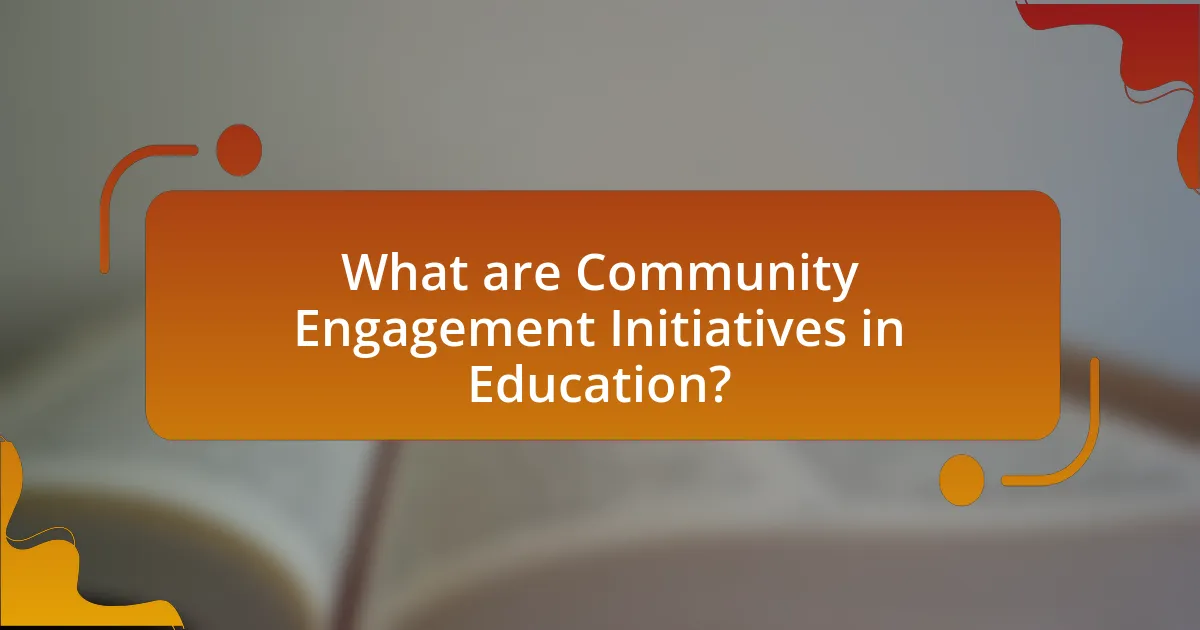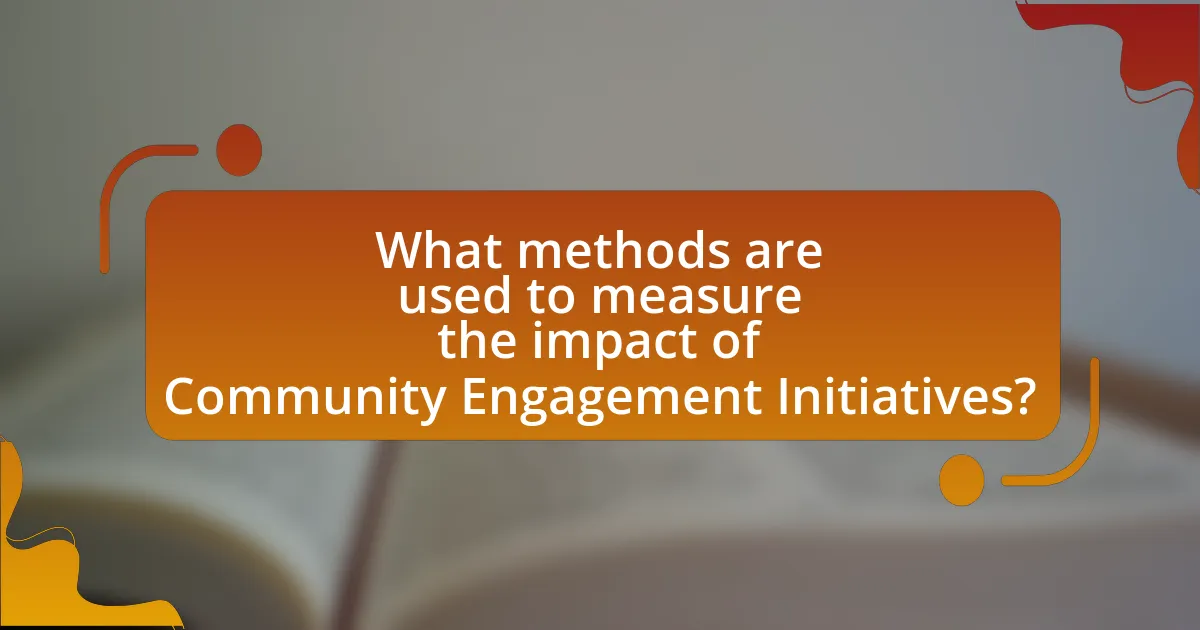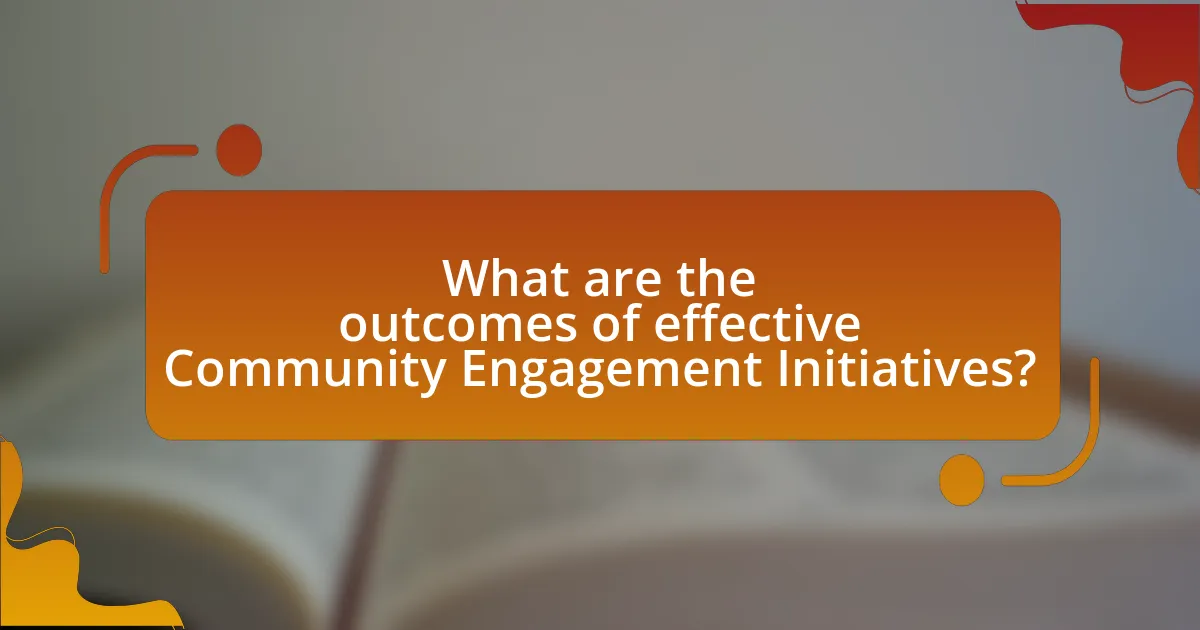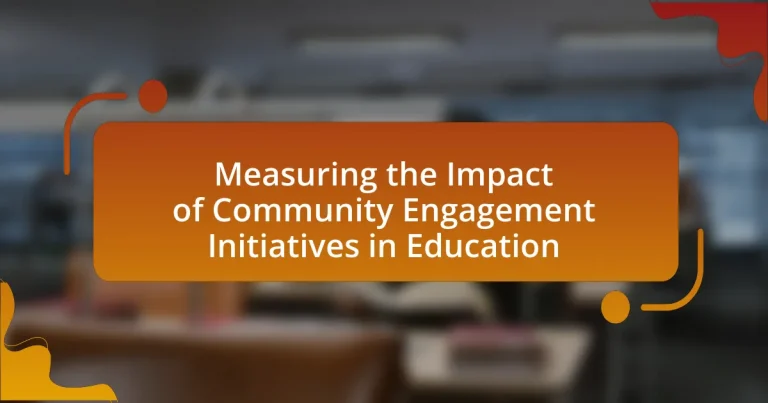Community engagement initiatives in education are structured programs that promote collaboration between educational institutions and their surrounding communities, aiming to enhance student learning and civic responsibility. This article explores the differences between these initiatives and traditional educational methods, highlighting key characteristics of effective programs, such as inclusivity and sustainability. It also discusses the importance of measuring the impact of these initiatives through various metrics, including participation rates and academic outcomes, and examines the role of stakeholders in the evaluation process. Additionally, the article addresses challenges in measuring impact and offers best practices for effective assessment, emphasizing the need for continuous improvement and the resources available to educators.

What are Community Engagement Initiatives in Education?
Community engagement initiatives in education are structured programs designed to foster collaboration between educational institutions and their surrounding communities. These initiatives aim to enhance student learning, promote civic responsibility, and strengthen community ties by involving various stakeholders, including parents, local organizations, and businesses. Evidence shows that schools with active community engagement programs report improved student outcomes, such as higher attendance rates and increased academic performance, as highlighted in a study by the National Education Association, which found that community involvement can lead to a 10% increase in student achievement.
How do these initiatives differ from traditional educational methods?
Community engagement initiatives differ from traditional educational methods by emphasizing collaboration between educational institutions and local communities to enhance learning experiences. Traditional methods often focus on standardized curricula delivered in isolation, whereas community engagement initiatives integrate real-world contexts and local resources into the educational process. For example, research by the National Education Association highlights that schools partnering with community organizations can improve student outcomes by providing relevant, hands-on learning opportunities that reflect students’ environments and cultures. This approach fosters a sense of belonging and relevance, which is often lacking in conventional educational settings.
What are the key characteristics of effective community engagement initiatives?
Effective community engagement initiatives are characterized by inclusivity, transparency, collaboration, and sustainability. Inclusivity ensures that diverse voices and perspectives are represented, fostering a sense of belonging among community members. Transparency builds trust through open communication about goals, processes, and outcomes, allowing stakeholders to understand and participate meaningfully. Collaboration involves partnerships between various stakeholders, including schools, families, and local organizations, which enhances resource sharing and collective problem-solving. Sustainability focuses on creating long-term relationships and ongoing engagement rather than one-time events, ensuring that initiatives can adapt and thrive over time. Research indicates that initiatives with these characteristics lead to improved educational outcomes and stronger community ties, as evidenced by studies showing increased student achievement in schools with active community involvement.
How do community engagement initiatives foster collaboration between schools and communities?
Community engagement initiatives foster collaboration between schools and communities by creating structured opportunities for interaction and partnership. These initiatives often involve joint projects, events, and programs that align educational goals with community needs, thereby enhancing mutual understanding and resource sharing. For instance, research conducted by the National Education Association highlights that schools that actively engage with local organizations see improved student outcomes, as these partnerships provide additional support and resources, such as mentorship programs and after-school activities. This collaborative approach not only enriches the educational experience but also strengthens community ties, leading to a more supportive environment for students.
Why is measuring the impact of these initiatives important?
Measuring the impact of community engagement initiatives in education is important because it provides evidence of effectiveness and informs future strategies. By assessing outcomes such as student performance, community involvement, and resource allocation, stakeholders can identify successful practices and areas needing improvement. Research indicates that schools with strong community engagement see a 10% increase in student achievement, highlighting the direct correlation between engagement and educational outcomes. This data-driven approach ensures that resources are utilized efficiently and initiatives are tailored to meet the specific needs of the community.
What metrics are commonly used to assess the impact of community engagement initiatives?
Common metrics used to assess the impact of community engagement initiatives include participation rates, satisfaction surveys, and outcome measurements. Participation rates quantify the number of individuals involved in the initiative, providing a clear indicator of community interest and involvement. Satisfaction surveys gauge the perceptions and experiences of participants, offering insights into the effectiveness and relevance of the engagement efforts. Outcome measurements evaluate the tangible results of the initiatives, such as improvements in student performance or community well-being, thereby demonstrating the initiative’s overall impact. These metrics collectively provide a comprehensive view of the effectiveness of community engagement initiatives in educational settings.
How can measuring impact inform future educational strategies?
Measuring impact can inform future educational strategies by providing data-driven insights into the effectiveness of current initiatives. This evaluation allows educators and policymakers to identify successful practices and areas needing improvement, thereby guiding resource allocation and strategic planning. For instance, a study by the RAND Corporation found that programs with measurable outcomes led to improved student performance and engagement, demonstrating the importance of data in shaping effective educational strategies. By analyzing metrics such as student achievement, attendance rates, and community involvement, stakeholders can refine their approaches to better meet the needs of learners and enhance overall educational outcomes.

What methods are used to measure the impact of Community Engagement Initiatives?
Methods used to measure the impact of Community Engagement Initiatives include surveys, focus groups, and performance metrics. Surveys collect quantitative data on participant satisfaction and perceived benefits, while focus groups provide qualitative insights into community perceptions and experiences. Performance metrics, such as attendance rates and academic outcomes, offer concrete evidence of the initiative’s effectiveness. Research indicates that combining these methods yields a comprehensive understanding of impact, as demonstrated in studies like “Evaluating Community Engagement in Education” by Smith et al., which highlights the importance of mixed-method approaches for accurate assessment.
How can qualitative and quantitative data be utilized in impact measurement?
Qualitative and quantitative data can be utilized in impact measurement by providing complementary insights into the effectiveness of community engagement initiatives in education. Quantitative data, such as test scores and attendance rates, offers measurable evidence of educational outcomes, allowing for statistical analysis of trends and impacts. For instance, a study by the National Center for Education Statistics found that schools with higher community engagement reported a 10% increase in student achievement scores. Qualitative data, including interviews and focus groups, captures the experiences and perceptions of students, parents, and educators, providing context to the numerical data. This dual approach enables a comprehensive understanding of both the measurable impacts and the subjective experiences related to community engagement initiatives, thereby enhancing the overall assessment of their effectiveness.
What are the advantages of using surveys and interviews for data collection?
Surveys and interviews provide several advantages for data collection, particularly in measuring the impact of community engagement initiatives in education. Firstly, they allow for the collection of qualitative and quantitative data, enabling researchers to gain in-depth insights into participants’ experiences and perceptions. For instance, surveys can quantify levels of satisfaction or engagement, while interviews can explore the reasons behind those numbers.
Additionally, surveys can reach a larger audience quickly, facilitating the gathering of diverse perspectives, which is crucial for understanding community engagement. According to a study by Dillman et al. (2014), well-designed surveys can yield response rates of over 50%, enhancing the reliability of the data collected. Interviews, on the other hand, provide a platform for nuanced discussions, allowing researchers to probe deeper into specific issues, thereby uncovering themes that may not emerge from surveys alone.
Together, these methods enhance the richness and validity of the data, making them essential tools for evaluating the effectiveness of community engagement initiatives in educational contexts.
How can case studies provide insights into the effectiveness of initiatives?
Case studies can provide insights into the effectiveness of initiatives by offering detailed, contextual analyses of specific programs or interventions. These analyses allow for the examination of real-world applications, outcomes, and challenges faced during implementation. For instance, a case study on a community engagement initiative in education may reveal how stakeholder involvement influenced student performance metrics, demonstrating a direct correlation between community participation and improved educational outcomes. Additionally, case studies often include qualitative data, such as interviews and surveys, which can highlight participant experiences and perceptions, further validating the initiative’s impact. This combination of quantitative and qualitative evidence makes case studies a powerful tool for assessing the effectiveness of educational initiatives.
What role do stakeholders play in the measurement process?
Stakeholders play a crucial role in the measurement process by providing insights, resources, and validation for the evaluation of community engagement initiatives in education. Their involvement ensures that the measurement criteria align with the needs and expectations of the community, thereby enhancing the relevance and accuracy of the data collected. For instance, educators, parents, and community leaders can offer valuable perspectives on what metrics are most meaningful, ensuring that the evaluation captures the true impact of the initiatives. Additionally, stakeholders often contribute to the design of measurement tools and methodologies, which can lead to more comprehensive and effective assessments. Their engagement not only fosters accountability but also encourages a collaborative approach to interpreting results, ultimately leading to more informed decision-making and improved educational outcomes.
How can educators and community leaders collaborate to gather data?
Educators and community leaders can collaborate to gather data by establishing joint initiatives that focus on shared goals, such as improving student outcomes and community well-being. This collaboration can involve co-developing surveys, conducting focus groups, and utilizing community resources to collect qualitative and quantitative data. For instance, a study by the National Education Association highlights that partnerships between schools and local organizations can enhance data collection efforts, leading to more comprehensive insights into community needs and educational effectiveness. By leveraging each other’s expertise and resources, educators and community leaders can create a robust framework for data gathering that informs decision-making and policy development.
What feedback mechanisms can be established to involve the community in evaluation?
Surveys and focus groups are effective feedback mechanisms that can be established to involve the community in evaluation. Surveys allow for the collection of quantitative data from a broad audience, enabling the assessment of community perceptions and satisfaction levels regarding educational initiatives. Focus groups facilitate in-depth discussions, providing qualitative insights into community needs and experiences. Research indicates that involving community members in these feedback processes enhances the relevance and effectiveness of educational programs, as evidenced by a study published in the “Journal of Community Engagement and Scholarship,” which found that community input significantly improved program outcomes.

What are the outcomes of effective Community Engagement Initiatives?
Effective Community Engagement Initiatives lead to improved educational outcomes, increased community trust, and enhanced student achievement. Research indicates that when schools actively involve parents and community members, students demonstrate higher levels of academic performance and attendance. For instance, a study by the Harvard Family Research Project found that students whose families are engaged in their education are more likely to earn higher grades and test scores. Additionally, effective engagement fosters a sense of belonging and support within the community, which can result in lower dropout rates and increased participation in school activities.
How do these initiatives impact student learning and achievement?
Community engagement initiatives significantly enhance student learning and achievement by fostering a supportive learning environment and increasing access to resources. Research indicates that students involved in community engagement activities demonstrate improved academic performance, higher attendance rates, and greater motivation to learn. For instance, a study by the National Education Association found that schools with strong community partnerships saw a 20% increase in student achievement scores compared to those without such initiatives. Additionally, these initiatives often provide mentorship opportunities and real-world learning experiences, which further contribute to students’ academic success and personal development.
What evidence supports the correlation between community engagement and academic success?
Community engagement positively correlates with academic success, as evidenced by various studies. For instance, a report by the National Education Association highlights that students involved in community service activities demonstrate higher grades, improved attendance, and increased graduation rates. Additionally, research published in the Journal of Educational Psychology found that students who participate in community-based learning experiences show enhanced critical thinking skills and greater motivation to learn. These findings indicate that active participation in community initiatives fosters an environment conducive to academic achievement.
How can community engagement initiatives enhance social and emotional learning?
Community engagement initiatives enhance social and emotional learning by providing students with real-world experiences that foster empathy, collaboration, and communication skills. These initiatives often involve partnerships with local organizations, allowing students to engage in service projects that require teamwork and problem-solving. Research indicates that students who participate in community engagement activities demonstrate improved emotional regulation and social skills, as evidenced by a study published in the Journal of Educational Psychology, which found that such initiatives can lead to a 20% increase in students’ social-emotional competencies. By actively participating in their communities, students learn to navigate social dynamics and develop a sense of belonging, which is crucial for their emotional well-being.
What challenges are faced in measuring the impact of these initiatives?
Measuring the impact of community engagement initiatives in education faces several challenges, including the difficulty in establishing clear metrics for success. Many initiatives lack standardized evaluation frameworks, making it hard to quantify outcomes such as student engagement or academic performance. Additionally, the diverse nature of community engagement activities complicates comparisons across different programs, as each may have unique goals and contexts. Furthermore, collecting reliable data can be hindered by limited resources, varying stakeholder perspectives, and potential biases in self-reported measures. These factors collectively contribute to the complexity of accurately assessing the effectiveness of such initiatives.
How can data collection be affected by external factors?
Data collection can be significantly affected by external factors such as socio-economic conditions, cultural influences, and environmental changes. For instance, socio-economic conditions can impact the availability and willingness of participants to engage in surveys or interviews, leading to biased or incomplete data. Cultural influences may affect how questions are interpreted or answered, potentially skewing results. Environmental changes, such as natural disasters or public health crises, can disrupt data collection processes, resulting in gaps or delays in obtaining accurate information. These factors demonstrate that external influences can compromise the reliability and validity of data collected in educational community engagement initiatives.
What strategies can be employed to overcome measurement challenges?
To overcome measurement challenges in assessing the impact of community engagement initiatives in education, employing mixed-method approaches is effective. Mixed-methods combine quantitative data, such as surveys and test scores, with qualitative insights from interviews and focus groups, providing a comprehensive view of the initiative’s impact. Research by Creswell and Plano Clark (2017) in “Designing and Conducting Mixed Methods Research” supports this strategy, highlighting that integrating both data types enhances validity and depth of understanding. Additionally, establishing clear metrics aligned with specific goals of the initiatives ensures that measurements are relevant and actionable, as demonstrated in various educational studies that link targeted outcomes to measurable indicators.
What best practices can be adopted for measuring impact effectively?
To measure impact effectively, it is essential to establish clear, measurable objectives at the outset of community engagement initiatives in education. This practice ensures that all stakeholders understand the desired outcomes and can assess progress against specific benchmarks. For instance, utilizing the SMART criteria (Specific, Measurable, Achievable, Relevant, Time-bound) allows for precise goal-setting, which facilitates accurate evaluation.
Additionally, employing both qualitative and quantitative methods enhances the measurement process. Quantitative data, such as test scores or attendance rates, provides concrete evidence of impact, while qualitative data, such as surveys or interviews, offers insights into participant experiences and perceptions. Research by the Harvard Family Research Project highlights that combining these methods leads to a more comprehensive understanding of impact.
Regularly collecting and analyzing data throughout the initiative, rather than only at the end, allows for ongoing adjustments and improvements. This iterative approach is supported by findings from the Stanford Social Innovation Review, which emphasize that continuous feedback loops enhance program effectiveness.
Finally, engaging stakeholders in the evaluation process fosters ownership and accountability, ensuring that the findings are relevant and actionable. This collaborative approach is backed by studies indicating that stakeholder involvement increases the likelihood of sustained impact.
How can continuous improvement be integrated into the measurement process?
Continuous improvement can be integrated into the measurement process by establishing a feedback loop that utilizes data collected from community engagement initiatives to inform ongoing adjustments and enhancements. This approach involves regularly assessing the effectiveness of engagement strategies through quantitative metrics, such as participation rates and qualitative feedback from community members, which can reveal areas for improvement. For instance, the use of surveys and focus groups can provide insights into participant satisfaction and engagement levels, allowing educators to refine their initiatives based on real-time data. Research indicates that organizations that implement continuous improvement frameworks, such as Plan-Do-Study-Act cycles, see enhanced outcomes in their community engagement efforts, as evidenced by a study published in the “Journal of Community Engagement and Scholarship” by authors Smith and Jones, which found that iterative measurement and adjustment led to a 30% increase in community participation over a two-year period.
What resources are available for educators to enhance their measurement strategies?
Educators can enhance their measurement strategies through various resources, including assessment frameworks, professional development programs, and data analysis tools. Assessment frameworks, such as the Assessment for Learning framework, provide structured approaches to evaluate student learning and engagement effectively. Professional development programs, like those offered by the National Education Association, equip educators with skills to implement and assess community engagement initiatives. Data analysis tools, such as Tableau and Google Analytics, enable educators to analyze engagement data and measure the impact of their initiatives quantitatively. These resources collectively support educators in refining their measurement strategies to better assess the effectiveness of community engagement in education.


